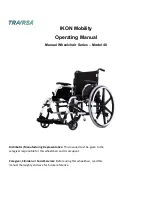
7
B.
General
Warnings
IV.
WARNINGS
WARNING:
Do
not
exceed
the
weight
limit
of
250
pounds
(350
pounds
for
heavy
duty
option)
for
the
Catalyst.
This
is
the
combined
weight
of
user
and
all
items
carried.
Exceeding
the
weight
limit
can
cause
damage
to
your
chair
or
increase
the
likelihood
of
a
fall
or
tip
back
resulting
in
severe
injury
or
death
to
the
user
or
others.
DANGER:
Do
not
use
this
chair
for
weight
training
.
The
movement
of
the
additional
weight
will
alter
the
center
of
gravity
of
the
wheelchair
increasing
the
likelihood
of
a
tip
‐
over
which
can
cause
damage
to
your
chair
or
cause
severe
injury
or
death
to
the
user
or
others
.
WARNING:
If
your
wheelchair
is
equipped
with
inflatable
tires,
make
sure
the
tires
have
been
inflated
to
the
correct
tire
pressure
as
indicated
on
the
side
wall
of
the
tire.
Your
wheelchair
provider
can
determine
if
you
have
inflatable
tires.
Using
your
wheelchair
without
properly
inflated
tires
can
have
an
effect
on
the
stability
of
the
wheelchair
causing
it
to
tip
over
resulting
in
death
or
injury
to
the
user
or
others.
DANGER:
Do
not
attempt
to
push
your
wheelchair
up
or
down
ramps
or
traverse
across
a
slope
of
greater
than
9
degrees
.
This
is
dangerous
and
increases
the
likelihood
of
a
fall
or
tip
back
resulting
in
severe
injury
or
death
to
the
user
or
others.
WARNING:
Do
not
attempt
to
push
your
wheelchair
up
an
incline
that
is
slick
or
coated
with
ice,
oil
or
water.
This
can
cause
an
unstable
situation
resulting
in
death
or
injury
to
the
user
or
others.
WARNING:
Do
not
lean
over
the
side
or
back
of
the
wheelchair
to
extend
your
reach.
This
may
cause
you
to
fall
out
of
the
wheelchair
or
the
wheelchair
to
tip
over
resulting
in
injury
or
death.
DANGER:
Do
not
attempt
to
the
lift
the
wheelchair
by
holding
on
to
removable
parts
such
as
the
arms
or
footrests.
Only
lift
the
wheelchair
by
holding
on
to
the
frame.
This
may
cause
a
fall
or
loss
of
control
and
result
in
serious
injury
or
death.
CAUTION:
Do
not
over
tighten
the
bolts
and
hardware
that
attaches
various
components
together
on
the
frame.
This
could
cause
serious
damage
and
af
‐
fect
the
safety
and
durability
of
the
wheelchair.
8
IV.
WARNINGS
C.
Positioning
Belts
Positioning
belts
are
designed
to
assist
with
proper
positioning
within
the
wheelchair.
They
are
not
designed
as
seat
belts.
Use
positioning
belts
ONLY
to
help
support
the
user’s
posture.
Misuse
of
positioning
belts
may
cause
se
‐
vere
injury
to
or
death
of
the
user.
Ensure
the
user
does
not
slide
underneath
the
positioning
belt
in
the
wheelchair
seat.
If
this
occurs,
the
users
breathing
may
be
hampered
causing
death
or
serious
injury.
The
positioning
belt
should
have
a
snug
fit;
tight
enough
to
hold
their
posi
‐
tion,
but
not
so
tight
as
to
restrict
breathing.
You
should
be
able
to
slide
your
hand
between
the
positioning
belt
and
the
user.
NEVER
Use
Positioning
Belts:
a)
As
a
restraint.
A
restraint
requires
a
doctor’s
order.
b)
On
a
user
who
is
unconscious.
c)
As
a
occupant
restraint
in
a
motor
vehicle.
A
positioning
belt
is
not
de
‐
signed
to
replace
a
seat
belt
that
is
attached
to
the
frame
of
a
vehicle,
which
would
be
required
of
an
effective
seat
belt.
During
a
sudden
stop,
with
the
force
of
the
stop,
the
user
would
be
thrown
forward.
Wheelchair
seat
belts
will
not
prevent
this,
and
further
injury
may
result
from
the
belts
or
straps.
DANGER:
Failure
to
comply
with
the
instruction
above
could
result
in
serious
injury
or
death.
Summary of Contents for 5 TTL
Page 1: ...1 2 Page Not In Use...





































